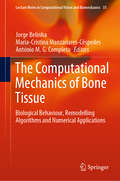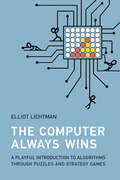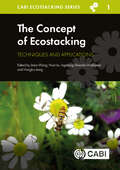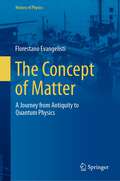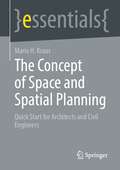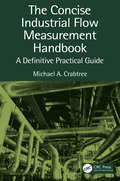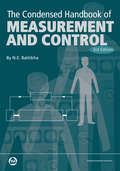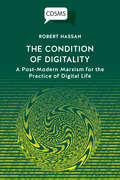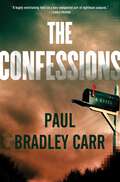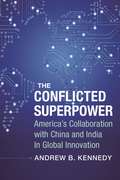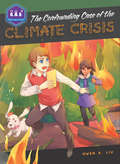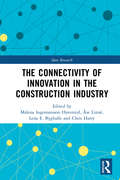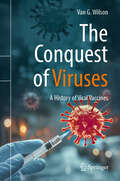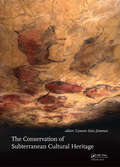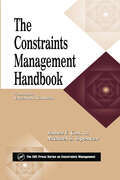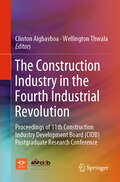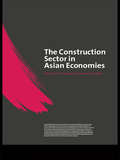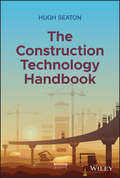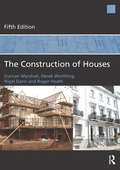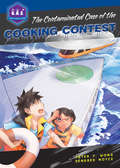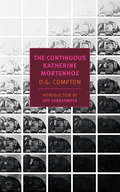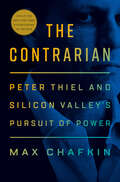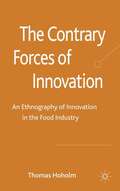- Table View
- List View
The Computational Mechanics of Bone Tissue: Biological Behaviour, Remodelling Algorithms and Numerical Applications (Lecture Notes in Computational Vision and Biomechanics #35)
by Jorge Belinha Maria-Cristina Manzanares-Céspedes António M. G. CompletoThis book offers a timely snapshot of computational methods applied to the study of bone tissue. The bone, a living tissue undergoing constant changes, responds to chemical and mechanical stimuli in order to maximize its mechanical performance. Merging perspectives from the biomedical and the engineering science fields, the book offers some insights into the overall behavior of this complex biological tissue. It covers three main areas: biological characterization of bone tissue, bone remodeling algorithms, and numerical simulation of bone tissue and adjacent structures. Written by clinicians and researchers, and including both review chapters and original research, the book offers an overview of the state-of-the-art in computational mechanics of bone tissue, as well as a good balance of biological and engineering methods for bone tissue analysis. An up-to-date resource for mechanical and biomedical engineers seeking new ideas, it also promotes interdisciplinary collaborations to advance research in the field.
The Computer Always Wins: A Playful Introduction to Algorithms through Puzzles and Strategy Games
by Elliot LichtmanAn engaging and approachable resource for beginning-to-intermediate coders eager to learn advanced ideas in computer programming.In The Computer Always Wins, Elliot Lichtman will teach you some of computer science&’s most powerful concepts in a refreshingly accessible way: exploring them through word games, board games, and strategy games you already know. Learn recursion by playing tic-tac-toe, efficient search through puzzle games like sudoku and Wordle, and machine learning by way of the playground classic rock-paper-scissors. Finish the book, and you&’ll come away with not only a deeper understanding of these foundational programming techniques but also a new appreciation for the amazing feats that can be accomplished using simple, readable code.
The Concept of Ecostacking: Techniques and Applications (Ecostacking Series)
by James D Blande Heikki M.T. Hokkanen Jarmo K Holopainen Tomislav Cernava Xian Wang Dr Ingeborg Menzler-Hokkanen Fanny Boerave Dr Daniel Carrillo Xiaoyulong Chen Wen-Qiang Chu Gloria Gauthura Severin Hatt Fathiya Khamis Pål Kvello Guang-Yun Li Dr Yaying Li Beatrice Muriithi Jinzhi Niu Levi Ombura Ziying Wang Qiu Yang Wei Yixia Wu Li Ya-Ying Kaijun ZhangEcostacking is a new concept and approach which aims to maximize the benefits of ecosystem service providers in cropping systems to help achieve the goal of long-term sustainable agriculture and food production. The term "ecostacking" means combining synergistically the beneficial services of functional biodiversity from all levels and types. It is a comprehensive approach, where the various ecosystem service providers are fully integrated with the rest of the cropping system including agronomic practices. It is an approach which goes beyond conventional Integrated Pest Management practises, and attempts to take advantage of all the functional biodiversity of a system. The main focus of ecostacking is on maximizing ecosystem services for biological control and pollination from beneficial arthropods, but the approach also utilizes other invertebrates (e.g., earthworms) as well as beneficial vertebrates such as bats, birds and small mammals. Microbes also provide invaluable ecosystem services including pest, disease, and weed control, either directly as components of "suppressive soils" or as plant colonizers (as endophytes or as epiphytic microbial flora). The ecostacking approach also aims to maximize other nature-provided services such as maintenance of soil health and nutrient cycling. The Concept of Ecostacking is the first book in a series which introduces ecostacking concepts to the reader and explores how this approach can be used in a variety of ways and in different cropping systems. The book defines this new concept and shows, using illustrative case studies from around the world, how ecostacking principles can be successfully employed in cropping systems in the open field, in greenhouses and in forestry. This book: · will serve as inspiration for developing further applications of this breakthrough technology for sustainable agricultural production. · is a must-read for everyone with an interest in developing sustainable crop protection systems and ecosystem management. · has been written and edited by the world's leading experts in this new and exciting endeavour.
The Concept of Matter: A Journey from Antiquity to Quantum Physics (History of Physics)
by Florestano EvangelistiOur current concept of matter, one of scientific research’s greatest successes, represents a long journey, from questions posed during the birth of philosophy in Ancient Greece to recent advances in physics and chemistry, including Quantum Physics. This book outlines that journey. The book has three parts, each detailing a phase of the journey. The first saw the development of a conception based on "classical" physics; the second saw the construction of the "old" quantum theory attempting to explain the mysterious properties of matter, resulting in formulation of the "new" quantum theory; the third saw the formation of the modern conception of matter, based on quantum mechanics. Along the way, various topics are discussed, including: rediscovery and appropriation of antiquity by Western culture in the modern era; the subsequent revision process in the 16th and 17th centuries and the new experiments and theories of the 18th; attempts to understand the mysterious properties of matter that could not be explained by classical physics; the first quantization hypotheses; discovery of new purely "quantum-mechanical" properties of matter; and the ultimate clarification of atomic structure. This book is aimed at anyone who wants a clear picture of how we arrived at the modern conception of matter.
The Concept of Space and Spatial Planning: Quick Start for Architects and Civil Engineers (essentials)
by Mario H. KrausSpace is an ambiguous and sometimes controversial term. Spatial planning is based on a delicate and changeable social balance, which is reflected in the legal basis (with German law code as example) and everyday implementation. In this essential, approaches from phenomenology are used to classify the various concepts of space.
The Concise Industrial Flow Measurement Handbook: A Definitive Practical Guide
by Michael A. CrabtreeThe Concise Industrial Flow Measurement Handbook: A Definitive Practical Guide covers the complete range of modern flow measuring technologies and represents 40 years of experiential knowledge within a wide variety of industries, and from more than 5000 technicians and engineers who have attended the author’s workshops. This book covers all the current technologies in flow measurement, including high accuracy Coriolis, ultrasonic custody transfer, and high accuracy magnetic flowmeters. The book also discusses flow proving and limitations of different proving methods. This volume contains over 300 explanatory drawings and graphs and is presented in a form suitable for both the beginner, with no prior knowledge of the subject, as well as the more advanced specialist. This book is aimed at professionals in the field, including chemical engineers, process engineers, instrumentation and control engineers, and mechanical engineers.
The Concise Manual of Apheresis Therapy
by Eisei Noiri Norio HanafusaThis pocket-sized manual serves as a concise and ideal reference work for therapeutic approaches using apheresis, Covering both basic theory and clinical details to facilitate improved treatment and patient outcomes, the text considers a variety of diseases, including myasthenia gravis, multiple sclerosis, Guillain-Barre syndrome, chronic inflammatory demyelinating polyneuropathy, nephrotic syndrome, TTP/TMA, dilated cardiomyopathy, and many other conditions. The books also reviews the growing trend towards adopting this unique therapy for a wide range of health management issues such as morbid obesity and/or type 2 diabetes, and for lowering LDL-cholesterol (cholesterol apheresis) in patients unresponsive to medication or lifestyle modification.
The Condensed Handbook of Measurement and Control
by N. E. BattikhaOther books on boiler control have been published; however, they do not cover engineering details on control systems and the setup of the various control functions. Boiler Control Systems Engineering provides specific examples of boiler control including configuration and tuning, valve sizing, and transmitter specifications.
The Condition of Digitality: A Post-Modern Marxism for the Practice of Digital Life (Critical Digital and Social Media Studies #2517-1623)
by Robert HassanDavid Harvey’s The Condition of Postmodernity rationalised capitalism’s transformation during an extraordinary year: 1989. It gave theoretical expression to a material and cultural reality that was just then getting properly started – globalisation and postmodernity – whilst highlighting the geo-spatial limits to accumulation imposed by our planet. However this landmark publication, author Robert Hassan argues, did not address the arrival of digital technology, the quantum leap represented by the move from an analogue world to a digital economy and the rapid creation of a global networked society. Considering first the contexts of 1989 and Harvey’s work, then the idea of humans as analogue beings he argues this arising new human condition of digitality leads to alienation not only from technology but also the environment. This condition he suggests, is not an ideology of time and space but a reality stressing that Harvey’s time-space compression takes on new features including those of ‘outward’ and ‘inward’ globalisation and the commodification of all spheres of existence. Lastly the author considers culture’s role drawing on Rahel Jaeggi’s theories to make the case for a post-modern Marxism attuned to the most significant issue of our age. Stimulating and theoretically wide-ranging The Condition of Digitality recognises post-modernity’s radical new form as a reality and the urgent need to assert more democratic control over digitality.
The Confessions: A Novel
by Paul Bradley CarrA high-octane and &“hugely entertaining&” (Chris Pavone, New York Times bestselling author) thriller about a supercomputer and the secrets we keep from one another—perfect for fans of Blake Crouch, Harlan Coben, and Gillian Flynn.Millions of letters arrive in the mail. Murders are uncovered, affairs revealed, family secrets exposed. These are the first Confessions. This is our last chance. LLIAM is the world&’s most powerful supercomputer, built to make the toughest decisions for its users. Where to work, who to marry, and even who should live or die. But when LLIAM suddenly goes offline with no explanation, the world is thrust into chaos, paralyzed by indecision. Stocks plummet, stores are shuttered, planes sit grounded on runways as humanity scrambles to re-adapt to an uncertain, analog world. Then the first letters arrive…on every continent, in every language, mysterious envelopes arrive in the mail, exposing people&’s darkest secrets, and most shocking crimes. All beginning with the same chilling words: &“We must confess.&” With millions of people suddenly made to confront their past transgressions, and society fast unraveling, CEO Kaitlan Goss must track down the only person who can help undo the resulting violent chaos: Maud Brookes, an ex-nun who taught LLIAM what it means to be human. But when Maud receives a letter herself, revealing Kaitlan&’s own unforgivable sin, the two women are forced into a deadly game of deceit as the world teeters on the brink. &“A timely, ticking clock thriller with unforgettable characters and psychological twists and turns you won&’t see coming. Read it. You won&’t regret it&” (Sarah Pinborough, author of We Live Here Now).
The Conflicted Superpower: America’s Collaboration with China and India in Global Innovation (A Nancy Bernkopf Tucker and Warren I. Cohen Book on American–East Asian Relations)
by Andrew KennedyFor decades, leadership in technological innovation has sustained U.S. power worldwide. Today, however, processes that undergird innovation increasingly transcend national borders. Cross-border flows of brainpower have reached unprecedented heights, while multinationals invest more and more in high-tech facilities abroad. In this new world, U.S. technological leadership increasingly involves collaboration with other countries. China and India have emerged as particularly prominent partners, most notably as suppliers of intellectual talent to the United States. In The Conflicted Superpower, Andrew Kennedy explores how the world’s most powerful country approaches its growing collaboration with these two rising powers.Whereas China and India have embraced global innovation, policy in the United States is conflicted. Kennedy explains why, through in-depth case studies of U.S. policies toward skilled immigration, foreign students, and offshoring. These make clear that U.S. policy is more erratic than strategic, the outcome of domestic battles between competing interests. Pressing for openness is the “high-tech community”—the technology firms and research universities that embody U.S. technological leadership. Yet these pro-globalization forces can face resistance from a range of other interests, including labor and anti-immigration groups, and the nature of this resistance powerfully shapes just how open national policy is. Kennedy concludes by asking whether U.S. policies are accelerating or slowing American decline, and considering the prospects for U.S. policy making in years to come.
The Confounding Case of Climate Crisis
by Owen R. Liu Barbara TinkerWith time travel and mysteries that need solving, the Galactic Academy of Science (G.A.S.) series instructs readers on how to think like scientists. Under the guidance of a Dude or Dudette from the future, the middle school characters are faced with treacherous, present-day crimes that require a historical knowledge of science in order to be solved. From investigating problems to analyzing data and constructing explanations and solutions, this series blends elements of sci-fi with educational methods that distill the key thinking habits of scientists and engineers. An adventure that investigates the causes and consequences of climate change Something strange is going on during Anita and Benson's field trip to a greenhouse as their guide is making wild claims about carbon dioxide and their science teacher, Mr. Fazmel, has mysteriously disappeared. That's when Quarkum Phonon, a Dude from the future, sends Anita and Benson on a Galactic Academy of Science mission to learn about the origins of climate change and the ways communities around the world are dealing with its impact. With stops around the world--from a Hawaiian volcano to Greenland and Geneva--Anita and Benson sift through the evidence for climate change. On their return home, the students face the question: what can a couple of kids do to reduce CO2 emissions and slow down climate change? A portion of all profits from this book will go to support local projects helping people in the developing world adapt to climate change.
The Connectivity of Innovation in the Construction Industry (Spon Research)
by Malena Ingemansson Havenvid Åse Linné Lena E. Bygballe Chris HartyThe construction industry is currently experiencing accelerating developments concerning societal demands along with project complexity, internationalization and digitalization. In an attempt to grasp the consequences of these demands on productivity and innovation, this edited book addresses how innovation is likely to take place with a more long-term perspective on the construction sector. While existing literature focuses on organizational discontinuity and fragmentation as the main reasons for the apparent lack of innovation in the industry, this book highlights the connectivity of construction actors, resources and activities as fundamental for understanding how innovation takes place.Through 15 empirically grounded chapters, the book shows how innovation is part of construction processes on various levels, including project, firm and industry, and that these innovation processes are characterized by organizational and technological connectivity over time. Written by European business management scholars, the chapters cover empirical cases and examples from both a multi-organizational and a multi-international perspective in terms of covering the viewpoints of different industry actors and the contexts of several different European countries including: Sweden, Norway, the UK, Italy, France, Hungary and Poland. By illustrating how connectivity is part of innovation processes in the creation of single-product innovations, of various innovations within and across projects, as well as a fundamental aspect of the processes in which innovations cross nations, the book provides a new angle on how to understand construction innovation and where the industry might (or needs to) be heading next. This book is essential reading for anyone interested in construction management, project management, engineering management, innovation studies, business and management studies.
The Conquest of Viruses: A History of Viral Vaccines
by Van G. WilsonThis book guides through the fascinating history of viral vaccines, from the first primitive smallpox vaccination in the 18th century to the cutting-edge RSV formulation approved in 2023. Each chapter delves into the scientific, clinical, and social forces that led to the development of these life-saving medical innovations, highlighting the scientists who played pivotal roles. With a focus on making complex science accessible and history engaging, this book offers a comprehensive portrayal of virology, vaccinology and the interplay between science and society in shaping public health. Readers will explore key concepts such as the evolution of vaccine technology over time, from cowpox material to mRNA vaccines, and a wide array of other topics, including the eradication of diseases through vaccines, the challenges of immunization against influenza, and the revolutionary impact of COVID-19 vaccination. The author, microbiologist Professor Wilson, provides expert analysis on how sociological factors influenced vaccine progress and gets to the bottom of the question of why there is still no vaccine for some critical diseases. This book is a must-read for anyone with an interest in viruses and vaccines. Whether you're a researcher or simply fascinated by medical history, this book promises to be both informative and entertaining.
The Conservation of Subterranean Cultural Heritage
by Cesareo Saiz-JimenezThis proceedings volume contains selected papers presented at the Workshop on the Conservation of the Subterranean Cultural Heritage, held 25-27 March 2014, in Seville, Spain. The workshop was organized by the Spanish Network of Science and Technology for the Conservation of Cultural Heritage (TechnoHeritage). Contributions cover the following fields: archaeology, history, conservation, maintenance and restoration, architectural sciences and engineering.
The Constraints Management Handbook (The CRC Press Series on Constraints Management)
by Michael S. Spencer III CoxA new approach to improving the production of goods and services, Constraints Management (CM), recognizes the powerful role of the constraint (the limiting resource) in determining the output of the entire production system. By learning about and mastering CM concepts, managers can improve their companies' present output and plan for future growth as well.
The Construction Alphabet Book (Jerry Pallotta's Alphabet Books)
by Jerry PallottaFor fans of all things that go this noisy alphabet book explores construction equipment from A to Z. Find out about these construction machines and more, from a huge saw that cuts through roads to a massive vacuum that sucks up boulders. You'll even learn a quick and easy recipe for concrete. Rock crushers, jackhammers, and wrecking balls will delight the youngest of readers learning their ABCs. Jerry Pallotta's trademark humor punctuates the informative text. Vibrant oil paintings bring to life a busy construction site.
The Construction Industry in the Fourth Industrial Revolution: Proceedings of 11th Construction Industry Development Board (CIDB) Postgraduate Research Conference
by Clinton Aigbavboa Wellington ThwalaThis book gathers papers from the 11th Construction Industry Development Board (cidb) Postgraduate Research Conference, held on 28–30 July 2019 in Johannesburg, South Africa. The conference provided an essential forum for reviewing and generating knowledge on Construction 4.0 and, consequently, highlighted processes and practices that allow us to deliver and operate built environment assets more effectively and efficiently by focusing on physical-to-digital and digital-to-physical transformation. The event addressed three broad themes: Industrial production (prefabrication, 3-D printing and assembly, offsite and advanced manufacturing);Cyber-physical systems (actuators, sensors, IoT, robots and cobots for repetitive and dangerous tasks, and drones for mapping, progress monitoring, safety and quality inspections, lifting, moving and positioning); and Technologies (digital ecosystems, digital platforms, BIM, video and laser scanning, AI and cloud computing, big data and data analytics, reality capture, blockchain, simulation, virtual and augmented reality, data standards and interoperability, and vertical and horizontal integration). Given its scope, the book will be of interest to all construction industry and architectural professionals who want to learn about cutting-edge technologies applied to construction
The Construction Sector in the Asian Economies
by John Raftery Michael Anson Y.H. ChiangThis collection of essential data on eleven Asian economies outlines new trends and highlighting increasing differences between developed and developing countries. The book features a detailed analysis of the state of the construction industry and its economic effects in Australia, China Mainland, China Hong Kong, India, Indonesia, Japan, South Korea, Philippines, Singapore, Sri Lanka and Vietnam.
The Construction Technology Handbook
by Hugh SeatonTired of new software that doesn’t seem to work in the field? Ready to get your teams up to speed and productive with the latest tools? The Construction Technology Handbook takes a ground up, no jargon look at technology in the construction industry. From clear, quickly grasped explanations of how popular software actually works to how companies both large and small can efficiently try out and onboard new tools, this book unlocks new ways for construction field teams, firm owners, managers, leaders, and employees to do business. You’ll learn about: Simple frameworks for making sense of all the new options cropping up How software and data work and how they work together to make your job easier and safer What artificial intelligence really is and how it can help real companies today Tools that are just over the horizon that will, one day, make your job just a little bit easier New and practical resources to help you incorporate an attitude of innovation and technology adoption into your workplace Perfect for general contractors and subcontractors, The Construction Technology Handbook also belongs on the bookshelves of construction technology vendors and construction workers who want to better understand the needs of the construction industry and the inner workings of construction technology, respectively.
The Construction of Houses
by Derek Worthing Duncan Marshall Roger Heath Nigel DannThe fifth edition of this successful textbook is aimed specifically at those students and practitioners who require a broad understanding of building construction as part of a wider sphere of professional activity. The book provides a comprehensive introduction to the principles and practice of modern construction and services. New to this edition are: Hundreds of revised graphics to complement the fully updated text New illustrations and photos printed in full colour for the first time New chapters on sustainability, ventilation and windows. This highly sought after text concentrates on principles and practice rather than details and regulations and retains it’s easy to follow format and highly accessible style. In doing so it enables the reader to demonstrate a comprehensive and genuine understanding of modern house construction and its evolution over the last 100 years. The Construction of Houses is not only an essential read for students, surveyors, developers and planning professionals, but also the interested lay person considering their first building project.
The Contaminated Case of Cooking Contest
by Peter WongWith time travel and mysteries that need solving, the Galactic Academy of Science (G.A.S.) series instructs readers on how to think like scientists. Under the guidance of a Dude or Dudette from the future, the middle school characters are faced with treacherous, present-day crimes that require a historical knowledge of science in order to be solved. From investigating problems to analyzing data and constructing explanations and solutions, this series blends elements of sci-fi with educational methods that distill the key thinking habits of scientists and engineers. The science of food safety combines with mystery in this G.A.S. adventure about an outbreak of foodborne illness When a cruise featuring a cooking contest turns into a disaster of vomiting passengers, seventh-grade G.A.S. trainees Mae and Clinton have a mystery to solve. With help from Selectra Volt, Dudette from the future, the two kids travel through time to learn about the science of food safety. Between journeys to the past, they investigate clues aboard ship. But when a storm comes, and conditions aboard the disabled ship become desperate, can Mae and Clinton discover the cause of the outbreak in time?
The Continuous Katherine Mortenhoe
by D. G. Compton Jeff VandermeerKatherine Mortenhoe lives in a near future very similar to the present day. Only in her time, dying from anything but old age is unheard of; death has been cured. So when Katherine is diagnosed with a terminal brain disease brought on by an inability to process an ever increasing volume of sensory input, she immediately becomes a celebrity to the "pain-starved public." But Katherine rejects her tragic role: She will not agree to be the star of a Human Destiny TV show, her last days will not be documented or broadcast. What she doesn't realize is that from the moment of diagnosis she's been watched, not only by television producers but by a new kind of program host, a man with a camera behind his unsleeping eyes.Like Margaret Atwood's MaddAddam trilogy, Kazuo Ishiguro's Never Let Me Go, and the television series Black Mirror, The Continuous Katherine Mortenhoe is a thrilling psychological drama that is as wise about human nature as it is about the nature of technology.
The Contrarian: Peter Thiel and Silicon Valley's Pursuit of Power
by Max ChafkinA biography of venture capitalist and entrepreneur Peter Thiel, the enigmatic, controversial, and hugely influential power broker who sits at the dynamic intersection of tech, business, and politics &“Max Chafkin&’s The Contrarian is much more than a consistently shocking biography of Peter Thiel, the most important investor in tech and a key supporter of the Donald Trump presidency. It&’s also a disturbing history of Silicon Valley that will make you reconsider the ideological foundations of America&’s relentless engine of creative destruction.&”—Brad Stone, author of The Everything Store and Amazon UnboundSince the days of the dot-com bubble in the late 1990s, no industry has made a greater impact on the world than Silicon Valley. And few individuals have done more to shape Silicon Valley than Peter Thiel. The billionaire venture capitalist and entrepreneur has been a behind-the-scenes operator influencing countless aspects of our contemporary way of life, from the technologies we use every day to the delicate power balance between Silicon Valley, Wall Street, and Washington. But despite his power and the ubiquity of his projects, no public figure is quite so mysterious.In the first major biography of Thiel, Max Chafkin traces the trajectory of the innovator's singular life and worldview, from his upbringing as the child of immigrant parents and years at Stanford as a burgeoning conservative thought leader to his founding of PayPal and Palantir, early investment in Facebook and SpaceX, and relationships with fellow tech titans Mark Zuckerberg, Elon Musk, and Eric Schmidt. The Contrarian illuminates the extent to which Thiel has sought to export his values to the corridors of power beyond Silicon Valley, including funding the lawsuit that destroyed the blog Gawker and strenuously backing far-right political candidates, notably Donald Trump for president in 2016. Eye-opening and deeply reported, The Contrarian is a revelatory biography of a one-of-a-kind leader and an incisive portrait of a tech industry whose explosive growth and power is both thrilling and fraught with controversy.
The Contrary Forces of Innovation
by Thomas HoholmThe complexity and tensions of industrial innovation processes are fleshed out through the analysis of an intriguing case study from the food industry. Drawing together insights from multiple disciplines, this book shows the controversial nature of innovation processes.
